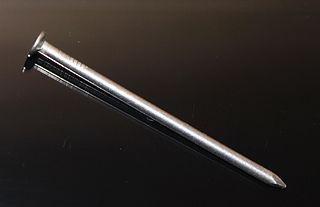
In woodworking and construction, a nail is a small object made of metal which is used as a fastener, as a peg to hang something, or sometimes as a decoration. Generally, nails have a sharp point on one end and a flattened head on the other, but headless nails are available. Nails are made in a great variety of forms for specialized purposes. The most common is a wire nail. Other types of nails include pins, tacks, brads, spikes, and cleats.

An air gun or airgun is a gun that uses energy from compressed air or other gases that are mechanically pressurized and then released to propel and accelerate projectiles, similar to the principle of the primitive blowgun. This is in contrast to a firearm, which shoots projectiles using energy generated via exothermic combustion (deflagration) of chemical propellants, most often black powder or smokeless powder.
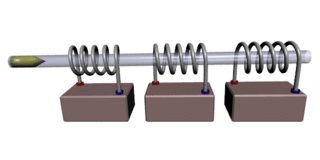
A coilgun is a type of mass driver consisting of one or more coils used as electromagnets in the configuration of a linear motor that accelerate a ferromagnetic or conducting projectile to high velocity. In almost all coilgun configurations, the coils and the gun barrel are arranged on a common axis. A coilgun is not a rifle as the barrel is smoothbore.

A zipper, zip, fly, or zip fastener, formerly known as a clasp locker, is a commonly used device for binding together two edges of fabric or other flexible material. Used in clothing, luggage and other bags, camping gear, and many other items, zippers come in a wide range of sizes, shapes, and colors. In 1892, Whitcomb L. Judson, an American inventor from Chicago, patented the original design from which the modern device evolved.
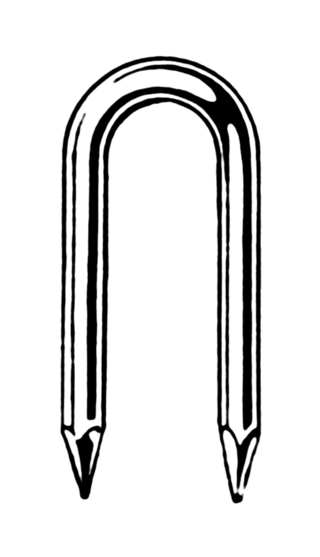
A staple is a type of two-pronged fastener, usually metal, used for joining, gathering, or binding materials together. Large staples might be used with a hammer or staple gun for masonry, roofing, corrugated boxes and other heavy-duty uses. Smaller staples are used with a stapler to attach pieces of paper together; such staples are a more permanent and durable fastener for paper documents than the paper clip.

A rivet is a permanent mechanical fastener. Before being installed, a rivet consists of a smooth cylindrical shaft with a head on one end. The end opposite the head is called the tail. On installation, the deformed end is called the shop head or buck-tail.
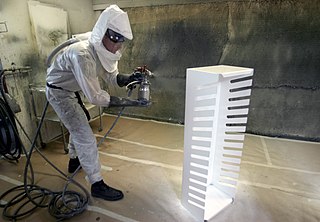
Spray painting is a painting technique in which a device sprays coating material through the air onto a surface. The most common types employ compressed gas—usually air—to atomize and direct the paint particles.

A fastener or fastening is a hardware device that mechanically joins or affixes two or more objects together. In general, fasteners are used to create non-permanent joints; that is, joints that can be removed or dismantled without damaging the joining components. Steel fasteners are usually made of stainless steel, carbon steel, or alloy steel.

A jackhammer is a pneumatic or electro-mechanical tool that combines a hammer directly with a chisel. It was invented by William McReavy, who then sold the patent to Charles Brady King. Hand-held jackhammers are generally powered by compressed air, but some are also powered by electric motors. Larger jackhammers, such as rig-mounted hammers used on construction machinery, are usually hydraulically powered. These tools are typically used to break up rock, pavement, and concrete.
A pneumatic weapon is a weapon that fires a projectile by means of air pressure, similar in principle to the operation of pneumatic tube delivery systems. The term comes from a Greek word for "wind" or "breath" (πνεῦμα).

A socket wrench is a type of spanner that uses a closed socket format, rather than a typical open wrench/spanner to turn a fastener, typically in the form of a nut or bolt.

A safety wire or locking-wire is a type of positive locking device that prevents fasteners from falling out due to vibration and other forces. The presence of safety wiring may also serve to indicate that the fasteners have been properly tightened.
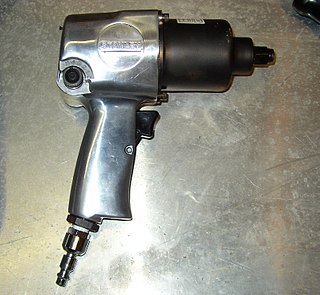
An impact wrench is a socket wrench power tool designed to deliver high torque output with minimal exertion by the user, by storing energy in a rotating mass, then delivering it suddenly to the output shaft. It was invented by Robert H. Pott of Evansville, Indiana.
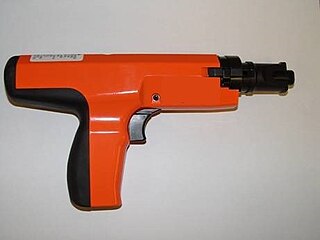
A powder-actuated tool is a type of nail gun used in construction and manufacturing to join materials to hard substrates such as steel and concrete. Known as direct fastening or explosive fastening, this technology is powered by a controlled explosion of a small chemical propellant charge, similar to the process that discharges a firearm.
A dynamite gun is any of a class of artillery pieces that use compressed air to propel an explosive projectile. Dynamite guns were in use for a brief period from the 1880s to the beginning of the twentieth century.

Paslode Impulse is a trademarked name for a cordless nail gun manufactured by Paslode. Cordless nail guns do not need an air compressor. Instead, they use what Paslode calls a "fuel cell", but is actually a very small two stroke engine which fires one ignition stroke for each nail driven, and reloads itself from a small metal can filled with pressurized flammable gas. It has a battery pack and a high-voltage power supply, to deliver a spark.

A rivet gun, also known as a rivet hammer or a pneumatic hammer, is a type of tool used to drive rivets. The rivet gun is used on rivet's factory head, and a bucking bar is used to support the tail of the rivet. The energy from the hammer in the rivet gun drives the work and the rivet against the bucking bar. As a result, the tail of the rivet is compressed and work-hardened. At the same time the work is tightly drawn together and retained between the rivet head and the flattened tail. Nearly all rivet guns are pneumatically powered. Those rivet guns used to drive rivets in structural steel are quite large while those used in aircraft assembly are easily held in one hand. A rivet gun differs from an air hammer in the precision of the driving force.

A potato cannon is a pipe-based cannon that uses air pressure (pneumatic), or combustion of a flammable gas, to launch projectiles at high speeds. They are built to fire chunks of potato, as a hobby, or to fire other sorts of projectiles, for practical use. Projectiles or failing guns can be dangerous and result in life-threatening injuries, including cranial fractures, enucleation, and blindness if a person is hit.

A screw is an externally helical threaded fastener capable of being tightened or released by a twisting force (torque) to the head. The most common uses of screws are to hold objects together and there are many forms for a variety of materials. Screws might be inserted into holes in assembled parts or a screw may form its own thread. The difference between a screw and a bolt is that the latter is designed to be tightened or released by torquing a nut.

A rail fastening system is a means of fixing rails to railroad ties or sleepers. The terms rail anchors, tie plates, chairs and track fasteners are used to refer to parts or all of a rail fastening system. The components of a rail fastening system may also be known collectively as other track material, or OTM for short. Various types of fastening have been used over the years.

























